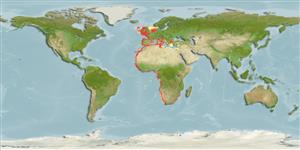Elasmobranchii (tubarões e raias) (sharks and rays) >
Carcharhiniformes (Ground sharks) >
Triakidae (Houndsharks) > Triakinae
Etymology: Mustelus: Latin, mustela, -ae = weasel (Ref. 45335).
Ambiente / Clima / Intervalo
Ecologia
; marinhas demersal; intervalo de profundidade 5 - 624 m (Ref. 56504), usually 5 - 50 m (Ref. 244). Temperate, preferred 26°C (Ref. 107945); 58°N - 34°S, 19°W - 36°E
Eastern Atlantic: UK to the Mediterranean, Morocco and Canary Islands; possibly Azores, Madeira, Angola to South Africa; including Indian Ocean coast. Often referred to as Mustelus canis which is restricted to the western Atlantic.
Length at first maturity / Tamanho / Peso / Idade
Maturity: Lm ?, range 80 - ? cm
Max length : 200 cm TL macho/indeterminado; (Ref. 27000); common length : 100.0 cm TL macho/indeterminado; (Ref. 26999); Idade máx. registada: 24 anos (Ref. 30745)
Espinhos dorsais (total): 0; Raios dorsais (total): 0; Espinhos anais 0; Raios anais : 0. A large, plain or black-spotted smoothhound (Ref. 5578). Uniformly grey or greyish-brown above, white below (Ref. 5578).
Found on the continental shelves and uppermost slopes, from the intertidal region to at least 350 m depth (Ref. 244). Collected to depth of 624 m in the eastern Ionian Sea (Ref. 56504). Sometimes in midwater but prefers to swim near the bottom (Ref. 244). Feeds mainly on crustaceans, but also cephalopods and bony fishes (Ref. 244). Viviparous, with a yolk-sac placenta (Ref. 244). Taken by shore and ski-boat anglers (Ref. 5578). Utilized for human consumption, oil, and fishmeal (Ref. 244). Sexual maturity is reached at a length of 70-80 cm (Ref. 35388).
Viviparous, with a yolk-sac placenta; 4 to 17 (Ref. 39938) young in a litter. Size at birth about 39 cm. Distinct pairing with embrace (Ref. 205).
Compagno, L.J.V., 1984. FAO Species Catalogue. Vol. 4. Sharks of the world. An annotated and illustrated catalogue of shark species known to date. Part 2 - Carcharhiniformes. FAO Fish. Synop. 125(4/2):251-655. Rome: FAO. (Ref. 244)
Status na Lista Vermelha da IUCN (Ref. 115185)
CITES (Ref. 94142)
Not Evaluated
Perigo para os humanos
Harmless
Uso pelos humanos
Pescarias: altamente comercial; peixe esportivo: sim
Mais informação
ReferênciasAquaculturaPerfil para aquaculturaEstirpesGenéticaFrequência alélicaHereditariedadeDoençasProcessamentoMass conversion
Ferramentas
Relatórios especiais
Baixar XML
Fontes da internet
